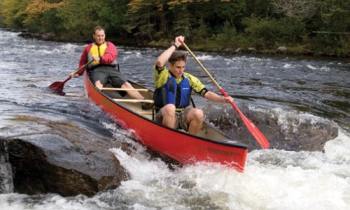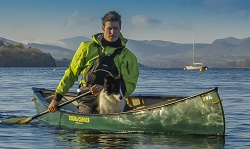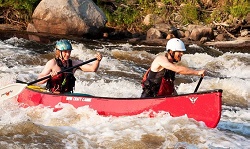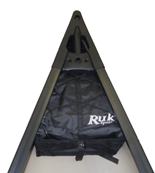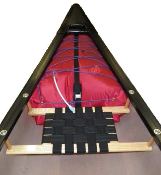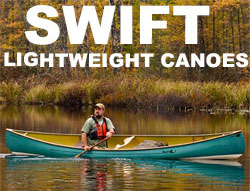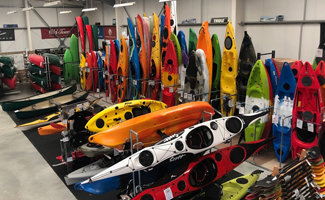Give us a call on 01603 747139 if you have any questions about the Choosing The Right Canoe
Which canoe is right for me?
Open or Canadian Canoes come in a variety of shapes and sizes and are capable of taking a single person or family on anything from a day trip to a full multi-day expedition.
As a general rule, the higher seating position in a Canoe gives and extremely comfortable paddling position and extra room to move about, Canoes are excellent for those who may have difficulty getting in or out of a kayak. And while the ride is usually drier although a little slower than a kayak, a Canoe allows for a greater amount of kit and equipment to be carried. This makes Canoes great for camping trips, expeditions and fishing trips.
Before choosing your Canoe there are a number of questions to ask yourself about what you really want from your time on the water. Canoes have a variety of features that effect their performance and thus make certain models more suitable than others.
Deciding what features and properties are most important to you from your new Canoe will allow you to narrow the field and optimise your time spent researching.
If you're having trouble choosing the right canoe, why not just give us a ring? We're always happy to help.
- Solo / Tandem
- Material
- Hull Shapes / Features
- Outfitting
- Accessories
Solo or Tandem?
The first question in selecting the right Canoe is "Am I going to be paddling on my own, or will I have company?"
If you're always going to be paddling solo, then perhaps a single seater really is the ideal canoe for you. Single seat canoes have the benefit of being generally that bit lighter, much easier to portage (carry around locks, weirs and other obstacles) and to car top. On the water they are highly manoeuvrable and easier to handle in windy conditions than the longer tandem versions. With enough space for camping equipment or fishing gear (or as with many canoeists, their dog), a solo Canoe can be perfect for a little personal adventuring. The drawbacks are that if someone suddenly says how they would love to come with you for a trip, you're unlikely to have any spare room for them.
With Tandem canoes, you obviously have more space for additional paddlers and/or kit. Tandem Canoes are traditionally between 14 and 18 feet long, come with a bow (front) and stern (rear) seat. The longer 16 foot and above open canoes have sufficient space for one or two additional seats. This makes them ideal for families or those looking to carry a lot of kit. However, this does not mean that they cannot be paddled solo. Many people purchase 14, 15, 16 or even 17 foot long canoes specifically because not only can they take the family, but also the canoe can be handled by one person with relative ease. As a general rule of thumb, longer canoes are faster, requiring less effort to maintain forward speed and easier to paddle in a straight line (also known as tracking). Shorter canoes are generally more easy to manoeuvre, but a little slower with reduced tracking ability.
View Solo Open Canoes for sale
View Tandem Open Canoes for sale
After that the next question is really 'What do I want to do in my canoe?'. Most canoes fall into a couple of general categories.
Recreational Canoes are generally stable, good for day trips, fishing, watching the wildlife and photography and outfitted with 2 or 3 comfortable seats. They are fairly easy to manoeuvre, track well is a straight line, be durable but not the fastest things out there. Basically a blend of everything.
See Nova Craft Prospector 15, Enigma Nimrod 14, Enigma Nimrod 15, Old Town Discovery 158
Touring Canoes tend to be longer with either a V or Shallow Arch hull shape, making them faster, or in other words less effort to paddle over a long distance. They will have a sharp entry line, long keel length but still possible to be paddled solo. They will also be able to carry more equipment and be made from a stiffer and possibly lighter material.
See Nova Craft Pal or Bob Special, Enigma Turing 17 or Enigma Turing 16
Down River Canoes will usually have plenty of rocker to them and be made of Royalex or another composite material. These are often favoured by solo paddlers even though they will normally still have 2 seats and be around 15 to 16 foot in length. They are easy to turn and handle for one person, with excellent secondary stability. Not as fast as a dedicated Touring Canoe, but a lot of fun and very versatile, especially on faster flowing water.
Material
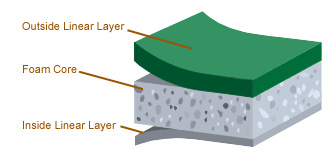
Most recreational Canoes are manufactured from either Plastic, or Royalex and Composite materials. Plastic, or more precisely Thermoformed or Roto-Moulded Polyethylene canoes are probably the most common form. These can be single, double or triple layers of plastic. As a general rule, the more layering in a plastic hull, the stiffer the canoe and therefore the better it handles on the water and the longer it should last. Also, many manufacturers use a middle foam-like plastic which improves the canoe buoyancy in much the same way as Royalex does but without the higher price tag. The drawback with plastic is that it tends to be the heavier of the 2 materials. This can be a issue if you have difficulty lifting or if you are looking for a tandem that can be used solo and need to car top it on your own.
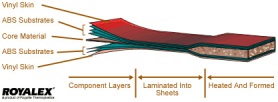
Royalex was an extremely popular form of plastic used in Canoe manufacture. However, Royalex production ceased in 2014. Royalex was a sandwich of ABS layers surrounding a foam core. This gave canoes made from Royalex a greater impact resistance, UV stability and durability with a slight weight saving over normal plastic hulls. However, Royalex canoes were easy to bruise and dent and removing scratches etc was very difficult.
Tuff Stuff is the latest material from Nova Craft. Is has been designed to take the place of Royalex and it delivers an amazing great blend of lightweight yet hard-wearing properties to their hulls. Tuff Stuff is a blend of Basalt and Innegra which gives Nova Craft canoes supreme stiffness and performance with unbelievable lightness and longevity.Over the top is a gel coat and although this still scratches, should you manage to crack the gel coat with a big impact it can be repaird easily by the owner to the point that you'd hardly know it was ever damaged in the first place. A lightweight tandem Nova canoe in Tuff Stuff really is the easiest of boats to car top, indeed many of their larger canoes weigh about the same as a small sit on top kayak!
Hull Shapes and Features
There are three main designs of canoe hull, each with its own properties.
Flat Hull

- Best Primary (Initial) stability
- Good on flat, calm waters
- Good for beginners
- Great for fishing and
wildlife
watching or photography - Old Town Saranac
- Pelican 15.5
Shallow Arch

- Best blend of Initial and
Secondary stability - Better tracking than flat hull
- Best shape for all-round use
- Best solo hull shape
- Nova Craft Prospector 15
- Nova Craft Prospector 16
Shallow V

- Best Secondary stability
- Fastest hull shape
- Excellent tracking ability
- Good for solo use and long distance paddling
- Enigma Nimrod 15
Each of these hull types have their own merits when taking into account stability. Stability itself can be broken down into 2 categories:
Primary Stability
This can be described as
how stable and flat the canoe is when the paddler or paddlers are simply sitting in their seats on the water.
Secondary Stability
This is how stable the canoe feels when it is leaned over. A canoe with good secondary stability can be gradually leaned further and further over in a smooth and controlled manner. It is also easy to lean over at an angle for solo paddling and keep it there with minimal effort, only tipping completely when the gunwales become submerged. A canoe with poor secondary stability will lean over and tip quickly.
Another important feature of canoe hulls to consider is 'Rocker'.
Rocker refers to the way a canoe hull is curved upwards at each end, making it look a little banana shaped. More Rocker makes a canoe more manoeuvrable and allows the boat to perform better on white water. However, it also makes a canoe harder to paddle in a straight line. Many canoeists who paddle tandem canoes solo will look for a rockered hull as it allows them to have a larger canoe without sacrificing manoeuvrability. Rockered canoes are also slightly slower than those with longer, flatter keels with reduced rocker as found in touring canoes.
Rockered canoe see Enigma Prospector.
Touring canoe see Enigma Turing 16.
Flare or Tumblehome?

The sides of a canoe can be said to have flare, be straight or have tumblehome. These refer to whether the side of the canoe curves outward, straight up or curves outward.
Freeboard simply refers to the height of the sides of a canoe. The more freeboard you have, the drier the ride generally and the more safe and enclosed you feel within. However, more freeboard also means a bigger wall for the wind to push against and that may make the canoe harder to handle in such conditions. The sides of your canoe can be straight, flared or have tumblehome. In a straight sided canoe, as the term suggests, the walls go straight up and down. With flare, the canoe is wider at the gunwales than at the waterline, and with Tumblehome the sides are narrower at the gunwale than at the waterline. A larger canoe with Tumblehome is far easier to paddle solo and either of the other 2 designs as you don't have to reach over so far to get an effective paddle stroke. A canoe with low freeboard and tumblehome sides is ideal for solo paddling.
Outfitting
The outfitting of your canoe can vary with the seating being probably the most important.
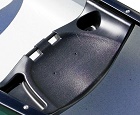
Plastic Canoe Seats
Canoe seat usually came as standard made from either plastic or wood. Plastic seats have the benefit of being hard-wearing with little or no maintenance required. They do have the drawback of being colder and a little less comfortable over longer periods of time.
See: Enigma Canoes.
You can also fit temporary canoe seats to accommodate a passenger.
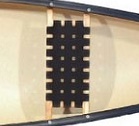
Wooden Canoe Seats
Wooden framed seats will have webbing straps or bootlace over them which are extremely comfortable and have the added benefit that in a tandem canoe which you wish to paddle solo, you can simply sit in the bow seat and face backwards for a fairly efficient solo paddling position.
See: Nova Craft, Old Town, Mad River and Enigma Canoes
Replacement seats and fixings can be found here.
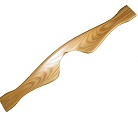
Other Features
Other features you will find in a good quality open canoe will be either a thwart and/or yoke. The thwart is there to provide structural rigidity to the canoe and also provides a bracing position for the paddler to kneel against if required. The yoke provides structural strength but also being located around the centre of the canoe it balances the weight and allows the canoe to be carried upside down on one persons' shoulders.
These features are occasionally removed when fitting additional seats into canoes.
Spare Yokes and Thwarts can be found here.
Kneeling thwarts
Kneeling Thwarts are very popular amongst canoeists that have a tandem boat, but also like to paddle it solo. Fitting a kneeling thwart is fairly straight forward and it allows you to trim the boat and paddle it from a more efficient position closer to the middle. However, for many who may just want to occasionally paddle their canoe solo, you can achieve much of the same effect by simply sitting in the bow paddler seat and face the stern of the boat, effectively paddling the canoe backwards.
View Kneeling Thwart
Accessories
Personalising your canoe very much depends on your needs. It can be something as simple as adding an extra temporary seat for when guests are paddling with you, to a complete outfitting for white water expeditions and camping trips. Canoes are extremely versatile, and with some careful choices, can be made ready for anything.Adding Extra Seats
Most open canoes will come with 2 seats as standard. Many of us like sharing our on the water experience with others, so additional seating often is required. This can be done in 2 different ways:
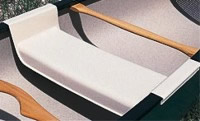
These nifty little seats simply clip over the gunwales of the canoe to give an extra seating position. In this way you can add 1 or 2 more seats quickly and precisely where you want them without worrying about drilling holes on your boat.
View Temporary and Permanent Canoe Seats

This is usually where a centre seat is required. Fitting a permanent third seat needs a lot more thought than a clip-in and will greatly effect your canoe. It will reduce the amount of space, effect the trim and may mean the removal of the carrying yoke. All these issues need to be considered before taking tools to your canoe. However, a permanent 3rd seat can make solo paddling easier for those who have trouble kneeling and be a more pleasant experience for the third person you've agreed to take out. Additional Buoyancy
Many people add blocks or bags to their canoes in order to bake them more buoyant. In the event of a capsize or rescue situation, they make the canoe a great deal easier to recover. It can be a fairly simple modification, the hard part is usually deciding on blocks or bags.
Buoyancy Blocks
Solid foam blocks with a hard-wearing outer cover. These are very popular because they are more durable without any puncture concerns. Buoyancy Blocks usually come in pairs with loops or straps fixed in place to help secure them into the canoe. Drawbacks might include a reduction of leg room for the bow paddler, having to remove a seat in order to fit the rear block and potentially needing to drill holes in your canoe.
Buoyancy Bags
Buoyancy Bags provide a less permanent option for canoes. They can be quite easily fitted and removed, reduced in size to give a little more leg room in the bow, and also will fit any shape of hull. (in some cases a block may need to be shaped for it to fit snugly). Bags are normally sold singly. They may puncture or have leaky valves and the amount of pressure in them can with the air
temperature.
Kneeling Thwart
A Kneeling Thwart provides a more efficient and comfortable position from which to paddle an open canoe solo. The paddlers weight is better distributed in the canoe allowing them to adjust the balance or 'trim' the boat correctly. This can also be improved by the placing of kit around the canoe. Fitting a kneeling thwart needs careful consideration and sometimes before drilling into position it is a good idea to temporarily clamp the thwart to the gunwale and paddle the boat. This way you can more the thwart position and get it right before and holes are made.
Painter Lines
Painter Lines are lengths of floating rope fixed to either the bow, stern or sometimes both. They can vary in length depending upon the preference of the paddler. Most painters will be at maximum the full length of the canoe. They can be useful for a variety of situations from towing and rescues, rafting up, securing to the bank, even useful for tying the bow of the boat to your car when transporting on a roof rack.
Painter Kits are available or just a length of floating rope will do the trick.
